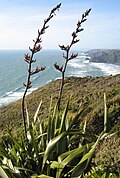Phormium
| New Zealand flax | |
|---|---|

| |
| Phormium tenax in bloom in Piha, West Auckland, New Zealand | |
| Scientific classification | |
| Kingdom: | Plantae |
| Clade: | Tracheophytes |
| Clade: | Angiosperms |
| Clade: | Monocots |
| Order: | Asparagales |
| Family: | Asphodelaceae |
| Subfamily: | Hemerocallidoideae |
| Genus: | Phormium J.R. Forst. & G. Forst. |
| Type species | |
| Phormium tenax | |
| Species | |
Phormium is a genus of two plant species in the family Asphodelaceae. One species is endemic to New Zealand and the other is native to New Zealand and Norfolk Island.[1] The two species are widely known in New Zealand as flax or their Māori names wharariki and harakeke respectively, and elsewhere as New Zealand flax or flax lily, but they are not closely related to the Northern Hemisphere's flax (Linum usitatissimum), which is native to the region extending from the eastern Mediterranean to India and has been used by humans since 30,000 B.C.[2][3]
Taxonomy
Monocot classification has undergone significant revision in the past decade, and recent classification systems (including the
Species
| Flower | Plant | Name | Distribution |
|---|---|---|---|
 |
 |
Phormium colensoi Hook.f. | New Zealand ( South Island, North Island) |
 |
 |
Phormium tenax J.R.Forst. & G.Forst. | New Zealand and Norfolk Island. |
The genus was originally established by the German
Description and ecology

Phormium is an
The rigid flower stalks can be up to 5 metres (16 ft) long, projecting high above the foliage. In November (in New Zealand) they produce clumps of curving tube-like flowers which turn bright red when mature. These produce unusually large quantities of nectar to attract all nectar-feeding birds such as the tūī and insects. The seedpods that develop after pollination, each contain hundreds of seeds which are later widely dispersed by the wind.
Distribution and habitat
Phormium tenax occurs naturally in New Zealand and Norfolk Island, while P. colensoi is endemic to New Zealand. Both species have been widely distributed to temperate regions of the world as economic fibre and ornamental plants.[7]
They are found mainly in swamps or low-lying areas but will grow in a variety of habitats.[8]
Cultivation
The two species readily interbreed and there is part considerable regional variation in Phormium colensoi.[9] Where the two species co-occur, there is local introgression.[10]
In recent years there has been a dramatic increase in the number of Phormium cultivars commercially available. The 2005-2006 edition of the Royal Horticultural Society Plant Finder listed 75 cultivars. As early as the 1920s it was recognised that ploidy plays a role in some cultivars due to the work of John Stuart Yeates.[11] The highly regarded sport Ngaro[12] was isolated from the Moutoa swamp, Foxton.[13]
The following cultivars have gained the Royal Horticultural Society's Award of Garden Merit for growing in UK gardens:[14]
Uses
Phormium produces long leaf fibres that have played an important role in the culture, history and economy of New Zealand. Both species have been widely distributed to temperate regions of the world as economic fibre and ornamental plants.
See also
References
- ^ Moore, L.B.; Edgar, E. (1970). Flora of New Zealand. Vol. II. Indigenous Tracheophyta: Monocotyledones except Gramineae. Wellington, N. Z.
{{cite book}}: CS1 maint: location missing publisher (link) - PMID 19745126.
- ^ Peter Coyne (2009). "Phormium tenax (New Zealand Flax)— Norfolk Island native?" (PDF). Cunninghamia. 11 (2): 167–170.
- ^ Kevin Mills (2009). "Was Phormium tenax introduced to Norfolk Island by the Polynesians?" (PDF). Cunninghamia. 11 (2): 171–175. Archived from the original (PDF) on 2011-03-11.
- ^ Cassell's Latin Dictionary, Marchant, J.R.V, & Charles, Joseph F., (Eds.), Revised Edition, 1928
- ^ Extraction, content, strength, and extension of Phormium variety fibres prepared for traditional Maori weaving, New Zealand Journal of Botany, 2000, Vol. 38: pg. 469.
- ^ McGruddy, Elizabeth (July 2006). "Integrating NZ flax into land management systems" (PDF). www.nzpcn.org.nz. Retrieved 18 May 2019.
- .
- S2CID 205448164.
- ^ "Papers Past — Evening Post — 21 December 1929 — FLAX RESEARCH". paperspast.natlib.govt.nz. 2011. Retrieved 24 October 2011.
- ^ paperspast.natlib.govt.nz/cgi-bin/paperspast?a=d&cl=search&d=EP19291221.2.108
- ^ "Maori dictionary - ngaro". Retrieved 26 May 2013.
- ^ "AGM Plants - Ornamental" (PDF). Royal Horticultural Society. July 2017. p. 78. Retrieved 25 April 2018.
- ^ "RHS Plant Selector - Phormium colensoi subsp. hookeri 'Cream Delight'". Retrieved 26 May 2013.[permanent dead link]
- ^ "RHS Plant Selector - Phormium colensoi subsp. hookeri 'Tricolor'". Retrieved 26 May 2013.[permanent dead link]
- ^ "RHS Plant Selector - Phormium 'Duet'". Retrieved 26 May 2013.[permanent dead link]
- ^ "RHS Plant Selector - Phormium 'Sundowner'". Retrieved 26 May 2013.
- ^ "RHS Plant Selector - Phormium tenax 'Variegatum'". Retrieved 26 May 2013.[permanent dead link]
- ^ "RHS Plant Selector - Phormium 'Yellow Wave'". Retrieved 26 May 2013.[permanent dead link]
